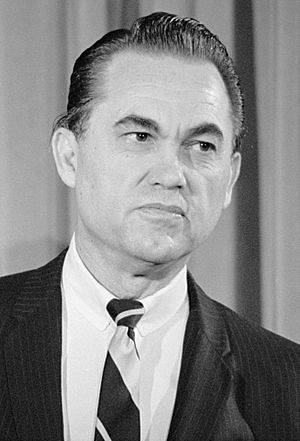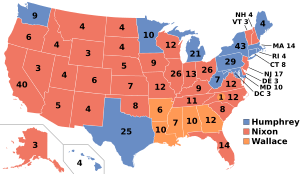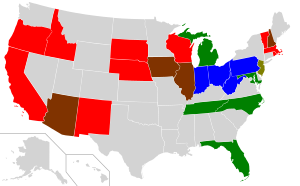George Wallace facts for kids
Quick facts for kids
George Wallace
|
|
|---|---|

Official portrait, 1962
|
|
| 45th Governor of Alabama | |
| In office January 17, 1983 – January 19, 1987 |
|
| Lieutenant | Bill Baxley |
| Preceded by | Fob James |
| Succeeded by | H. Guy Hunt |
| In office January 18, 1971 – January 15, 1979 |
|
| Lieutenant | Jere Beasley |
| Preceded by | Albert Brewer |
| Succeeded by | Fob James |
| In office January 14, 1963 – January 16, 1967 |
|
| Lieutenant | James Allen |
| Preceded by | John Patterson |
| Succeeded by | Lurleen Wallace |
| First Gentleman of Alabama | |
| In role January 16, 1967 – May 7, 1968 |
|
| Governor | Lurleen Wallace |
| Preceded by | Lurleen Wallace (as First Lady) |
| Succeeded by | Martha Farmer Brewer (as First Lady) |
| Member of the Alabama House of Representatives from Barbour County |
|
| In office 1946–1952 |
|
| Personal details | |
| Born |
George Corley Wallace Jr.
August 25, 1919 Clio, Alabama, U.S. |
| Died | September 13, 1998 (aged 79) Montgomery, Alabama, U.S. |
| Resting place | Greenwood Cemetery |
| Political party | Democratic |
| Other political affiliations |
American Independent (1968) |
| Spouses |
Lurleen Burns
(m. 1943; died 1968)Cornelia Ellis Snively
(m. 1971; div. 1978)Lisa Taylor
(m. 1981; div. 1987) |
| Children | 4 |
| Education | University of Alabama (LLB) |
| Signature | |
| Military service | |
| Allegiance | United States |
| Branch/service | United States Army |
| Years of service | 1942–1945 |
| Rank | Staff Sergeant |
| Unit | United States Army Air Forces |
| Battles/wars | World War II |
George Corley Wallace Jr. (born August 25, 1919 – died September 13, 1998) was an American politician. He served as the governor of Alabama four times. He was a member of the Democratic Party. Wallace is known for his strong views on keeping people of different races separate, which was called segregation. He also supported "populist" ideas, meaning he tried to appeal to regular people.
During his time as governor, he focused on helping businesses grow, keeping taxes low, and creating trade schools. Wallace tried to become the President of the United States four times but was never successful. He was a major figure during the Civil Rights Movement. He famously opposed desegregation, which was the effort to end racial separation. In his 1963 speech when he became governor, he even said he stood for "segregation now, segregation tomorrow, segregation forever." Later in his life, his views on race changed, and he apologized for his past actions.
Contents
Early Life and Education
George Corley Wallace Jr. was born in Clio, Alabama. His parents were George Corley Wallace Sr. and Mozelle Smith. People called him "George C." to tell him apart from his father and grandfather. He had two younger brothers and a sister.
From a young age, George was very interested in politics. When he was 15, he won a contest to work as a page in the Alabama Senate. He even predicted he would become governor someday! In high school, he was a successful boxer. After high school, he went straight to law school in 1937 at the University of Alabama School of Law. He earned his law degree in 1942.
In 1943, Wallace joined the United States Army Air Forces (USAAF). He became a flight engineer on B-29 planes. During World War II, he flew missions over Japan. He reached the rank of staff sergeant. In 1945, he left the military early due to health reasons.
Early Career in Politics
In 1945, Wallace became an assistant attorney general in Alabama. In 1946, he won his first election to the Alabama House of Representatives. At this time, he was seen as fair on racial issues. For example, he did not join a group of Southern politicians who walked out of a meeting in 1948 because they disagreed with new civil rights ideas.
In 1952, he became a judge in Alabama. He was known as "the fighting little judge" because of his boxing past. He had a reputation for being fair to everyone, no matter their race. A black lawyer named J. L. Chestnut Jr. later said that Wallace was the first judge in Alabama to call him "Mister" in court. However, Wallace also tried to stop the removal of signs that separated people by race in train stations. He also tried to block federal efforts to check voter lists in his county.
First Run for Governor
In 1958, Wallace ran for governor of Alabama for the first time. In Alabama at that time, the Democratic Party was very strong. So, winning the Democratic primary election was almost like winning the election itself. Wallace's main opponent was John Malcolm Patterson. Patterson had the support of the Ku Klux Klan, a group Wallace had spoken against. Wallace was supported by the NAACP, a civil rights organization. Wallace lost this election.
After losing, Wallace reportedly said he would "never be outniggered again." This meant he would take a much tougher stance on racial segregation to win over white voters. He then became a strong supporter of segregation.
Governor of Alabama: First Term
In 1962, Wallace ran for governor again and won easily. He became governor on January 14, 1963. In his speech, he promised to keep segregation in Alabama.
Standing Against Desegregation
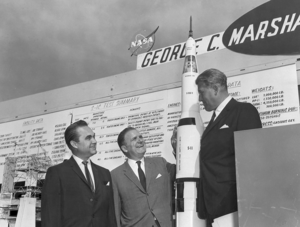
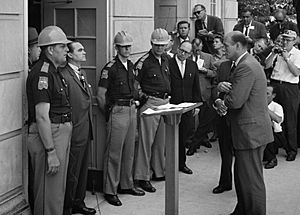
In 1963, President John F. Kennedy's government ordered the University of Alabama to allow black students to enroll. On June 11, 1963, Governor Wallace famously stood in front of the entrance to the university. He tried to block black students Vivian Malone and James Hood from entering. This event became known as the "Stand in the Schoolhouse Door." Federal officials eventually made him step aside, and the students were able to enroll.
Later that year, Wallace also tried to stop four black students from enrolling in elementary schools in Huntsville. A federal court stepped in, and the children were allowed to attend school. These were the first black students to integrate primary or secondary schools in Alabama.
Wallace believed that the federal government should not interfere with Alabama's laws. He also thought that desegregation would lead to problems.
Focus on Economy and Education
Even with his controversial stance on race, Wallace also focused on improving Alabama's economy. He was the first Southern governor to visit companies in other states. He offered them tax breaks and other benefits if they built factories in Alabama. This helped bring new jobs and industries to the state.
He also started a system of community colleges across Alabama. These colleges helped many students prepare for four-year degrees. Several colleges are named after him or his family, including Wallace Community College and Lurleen B. Wallace Community College. The University of South Alabama was also started during his first year as governor.
Presidential Campaigns
1964 Democratic Primaries
After gaining national attention, Wallace decided to run for president in 1964. He challenged the sitting president, Lyndon B. Johnson, for the Democratic nomination. Wallace campaigned strongly against integration and promised to be tough on crime. He did surprisingly well in some states, getting about a third of the votes in Wisconsin, Indiana, and Maryland.
Wallace was known for his powerful speeches. He could really get crowds excited.
1968 Third-Party Run
Because of term limits, Wallace could not run for governor again in 1966. So, his wife, Lurleen Wallace, ran instead and won. She became the first woman elected governor of Alabama. George Wallace was known as the "First Gentleman" and still had a lot of influence. Sadly, Lurleen died of cancer in 1968.
In 1968, George Wallace ran for president again, but this time as a candidate for the American Independent Party. He chose Curtis LeMay, a former Air Force General, as his running mate. Wallace hoped to win enough electoral votes to prevent either major party candidate from winning outright. This would force the House of Representatives to choose the president. He hoped this would give Southern states more power to stop desegregation efforts.
Wallace's campaign focused on "law and order." He criticized hippies and "pointy-headed intellectuals." He said there was "not a dime's worth of difference" between the two main parties. He won five Southern states and nearly ten million popular votes. However, Richard Nixon won the election. Wallace was the last candidate from a third party to win electoral votes from any state.
Many people, including later Republican leaders, learned from Wallace's campaign style. He showed how to appeal to white voters who were unhappy with federal civil rights laws.
Second Term as Governor and Assassination Attempt
In 1970, Wallace ran for governor again and won. He defeated the current governor, Albert Brewer. Wallace's campaign used strong language about race.
1972 Democratic Primaries and Shooting
In 1972, Wallace ran for president as a Democrat again. He said he no longer supported segregation and was a "moderate" on race. He was doing very well in the primaries, winning many states.
However, on May 15, 1972, while campaigning in Maryland, he was shot by a man named Arthur Bremer. Wallace was seriously injured and became paralyzed below the waist. He used a wheelchair for the rest of his life. The shooting effectively ended his presidential campaign.
Despite his injuries, Wallace still won primaries in Maryland and Michigan. He even spoke at the Democratic National Convention from his wheelchair. While he was recovering, the Lieutenant Governor, Jere Beasley, served as acting governor of Alabama.
Later Life and Final Term
Changing Views on Race
In the late 1970s, Wallace said he became a born-again Christian. He began to change his views on race. He apologized to black civil rights leaders for his past actions. In 1979, he said his stand in the schoolhouse door was "wrong" and that "those days are over." He publicly asked for forgiveness from black Americans.
Final Term as Governor
In 1982, Wallace ran for governor for a fourth and final time. He won the election, even though many thought a Republican might win that year.
During his last term (1983–1987), Wallace appointed many black Americans to state positions. For the first time, two black Americans served in his cabinet at the same time. On April 2, 1986, Wallace announced he would not run for governor again. He retired from public life in January 1987. He served a total of 16 years as governor, making him one of the longest-serving governors in U.S. history.
Family Life
Wallace married Lurleen Burns in 1943. They had four children: Bobbi Jo, Peggy Sue, George III, and Janie Lee. Lurleen became the first woman elected governor of Alabama. She ran because her husband could not run again due to term limits. She sadly died of cancer in 1968.
Their son, George Wallace Jr., also became involved in Alabama politics. He served as state treasurer and on the Public Service Commission.
Wallace married Cornelia Ellis Snively in 1971. She was the niece of a former Alabama governor. They divorced in 1978. In 1981, Wallace married Lisa Taylor, a country music singer. They divorced in 1987.
His daughter, Peggy, shared that it was hard growing up as his child. People sometimes treated her badly because of her father's views on segregation.
Final Years and Death
In his later years, George Wallace had hearing loss and developed Parkinson's disease. He was often in pain from his old gunshot injury. He continued to meet with friends and visitors until a few weeks before he died.
George Wallace died on September 13, 1998, in Montgomery, Alabama. He was 79 years old. He died from an infection and had problems with his breathing. He is buried in Greenwood Cemetery in Montgomery.
Legacy and Honors
Even though George Wallace never became president, he had a huge impact on American politics. Some historians call him "the most influential loser" in 20th-century American politics. He influenced how later politicians, like Richard Nixon and Ronald Reagan, talked about certain issues.
The George Wallace Tunnel on Interstate 10 in Alabama is named after him. There have been documentaries and movies made about his life, including "George Wallace: Settin' the Woods on Fire" and a TNT movie called "George Wallace" starring Gary Sinise.
Three community colleges in Alabama are named for Wallace: Wallace Community College, Wallace Community College Selma, and Wallace State Community College. His wife, Lurleen, also has a college named after her. In recent years, some universities have discussed renaming buildings that were named after Wallace.
See also
 In Spanish: George Wallace para niños
In Spanish: George Wallace para niños
- Electoral history of George Wallace
- Southern Democrats


